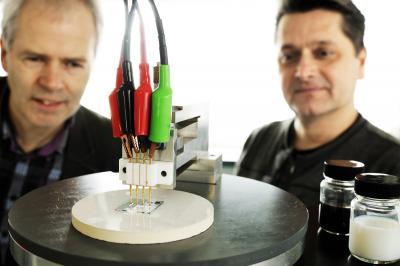Researchers at Eindhoven University of Technology (TU/e, Netherlands) have developed a replacement for indium tin oxide (ITO), an important material used in displays for all kinds of everyday products such as TVs, telephones and laptops, as well as in solar cells. Unfortunately indium is a rare metal, and the available supplies are expected to be virtually exhausted within as little as ten years. The replacement material is a transparent, conducting film produced in water, and based on electrically conducting carbon nanotubes and plastic nanoparticles. It is made of commonly available materials, and on top of that is also environment-friendly. The results, which also provide new insights into conduction in complex composite materials, were published online yesterday 10 April by the scientific journal Nature Nanotechnology.
The research team has been able to achieve higher conductivity by combining low concentrations of carbon nanotubes and conducting latex in a low-cost polystyrene film. The nanotubes and the latex together account for less than 1 percent of the weight of the conducting film. That is important, because a high concentration of carbon nanotubes makes the film black and opaque, so the concentration needs to be kept as low as possible. The research team was led by theoretical physicist Paul van der Schoot and polymer chemist Cor Koning. Post-doc Andriy Kyrylyuk is the first author of the paper in Nature Nanotechnology.
The researchers use standard, widely available nanotubes which they dissolve in water. Then they add conducting latex (a solution of polymer beads in water), together with a binder in the form of polystyrene beads. When the mixture is heated, the polystyrene beads fuse together to form the film, which contains a conducting network of nanotubes and beads from the conducting latex. The water, which only serves as a dispersing agent in production, is removed by freeze-drying. The 'formula' is not a question of good luck, as the researchers first calculated the expected effects and also understand how the increased conductivity works.

4-point conductivity measurement of the new transparent conducting film developed by Professors Cor Koning (left) and Paul van der Schoot (right). The black pot contains a dispersion of carbon nanotubes in water, and the white pot contains the conducting latex.
(Photo Credit: Photo: Bart van Overbeeke.)
The conductivity of the transparent e film is still a factor 100 lower than that of indium tin oxide. But Van der Schoot and Koning expect that the gap can quickly be closed. "We used standard carbon nanotubes, a mixture of metallic conducting and semiconducting tubes", says Cor Koning. "But as soon as you start to use 100 percent metallic tubes, the conductivity increases greatly. The production technology for 100 percent metallic tubes has just been developed, and we expect the price to fall rapidly." However the conductivity of the film is already good enough to be used immediately as an antistatic layer for displays, or for EMI shielding to protect devices and their surroundings against electromagnetic radiation.
The film has an important advantage over ITO: it is environment-friendly. All the materials are water based, and no heavy metals such as tin are used. The new film is also a good material for flexible displays.
The researchers themselves are very positive about the diversity of their team, which they believe made an important contribution to the results. "We had a unique combination of theoreticians, modeling specialists and people to do practical experiments", says Paul van der Schoot. "Without that combination we wouldn't have succeeded."